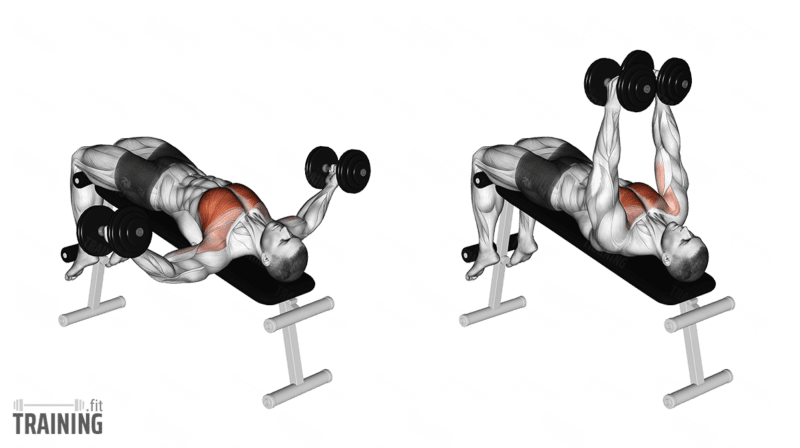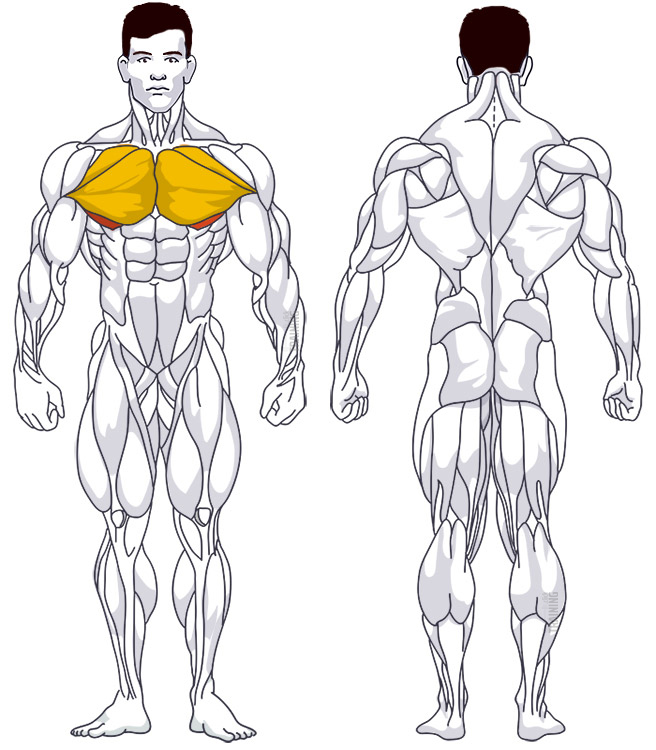Decline Flys
Isolation exercise, Free weightsOverview

Main muscles
- Chest: Large pectoral muscle
(Musculus pectoralis major) - Chest: Small pectoral muscle
(Musculus pectoralis minor)
Training plans
Decline Flys is a suitable substitute for similar exercises in lower chest training or as a supplement to various training plans.
Decline Flys: Basics and alternatives

Involved main muscle groups:
Decline Flys
In Decline Flys, you lie on a decline bench, making it a variation of the popular Flys exercise for the chest muscles. The movement’s the same: lie on your back, spread your arms holding dumbbells, and lift them above your body.
Decline Flys effectively target your chest muscles, giving you a fantastic muscle-building sensation. The decline bench angle shifts the focus from the middle to the lower chest, turning Decline Flys into an isolation exercise for the lower chest.
You can also try this exercise in other variations on the floor, incline bench, or cable machine.
Correct execution
Executing the exercise properly isn’t too difficult, but it needs focus initially. It’s vital to move both arms evenly to avoid creating an imbalance in your routine that’s hard to fix later.
Make sure your elbows stay at a fixed angle throughout the movement.
There’s no set rule for the bench’s decline angle. Experiment with different angles (if the bench allows it) to find what works best for you. As you progress, vary the angle occasionally to create new muscle stimuli.
Video tutorial
Step-by-step instructions
Hold a dumbbell in each hand and sit on the decline bench. Secure your legs under the pads. Hold the dumbbells near your belly.
Lean back, taking the dumbbells to your chest without swinging. Lie flat on the bench’s back pad.
While lying safely on the decline bench (head, shoulders/shoulder blades, and butt touching the bench), lift the dumbbells straight up in front of your torso.
Pull your shoulder blades back.
Bend your elbows about 10 degrees. Slowly lower the dumbbells by spreading your arms, stretching your chest in the final position. Don’t lower the dumbbells too far (see below).
Raise the dumbbells by rotating your arms up. Keep your elbows bent at the same angle throughout the entire movement, and your shoulder blades tight and pulled back.
After finishing your set, lower the dumbbells toward your chest and stand up if needed with a bit of momentum. Don’t just drop the dumbbells from the spread-arm position at the end of the exercise.
Common mistakes
As with traditional Flys, it’s crucial not to lower the weights too far. Although it’s tempting to achieve a greater chest stretch, it distorts the movement pattern and puts unnecessary stress on your shoulders. Lower the weights as far as you can without straightening your elbows, lifting your chest, or rotating your shoulders.
Also, keep your elbows bent. Despite the exercise’s name, your arms shouldn’t flap like wings. Maintain a slight bend in your elbows throughout the entire movement, and keep your shoulder blades pulled in and not pushed forward at the end of the movement.